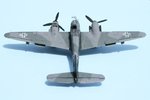N4521U
Plastic Pirate
[SC] Arachnicus;905598 said:Do you have a bit more detailed instructions?
Detailed instruction?
Before you have the wings attached, take one wing and the 3 or 4 view section of the instructions to a copy machine. Reduce or enlarge so the wing fits the copied image. Then copy all of the views as they should all be the same in scale. Make several to waste.
Then cut the patterns out with scissors. Now use some of the flexible glue tac, make little thin snakes of it and attach to the underside of the paper about 1/4" in from the edge and attach to the plane in it's place. If you want it to look older, use a thicker snake to get the paper further off the plane.
You will have to fake in the joining pieces from wing to top of engine cowling and sides to the top of the fuselage. Don't get too bloody frustrated with this joining of shapes, it's just paper! When you got it like you want it, spray your brains out.
Give it a go, once you've tried it you'll get to understand what you need to do to get where you want it to be.
Good luck mate.

